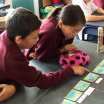Develop speech sounds
Understand the steps in developing speech sounds. Use a strengths-based approach to identify the student’s needs and next steps.
On this page:
On this page:
Current page section: Develop speech sounds
Go to top of current page: Develop speech sounds
Go to top of current page: Develop speech sounds
Go to top of current page: Develop speech sounds
Identify what the student can do
Identify what the student can do
Identify the next steps for ākonga in the development of their speech sounds.
See Stepping stones in oral language, Te Whāriki Online and the English learning area of NZC.
Understand the speech sounds of Aotearoa New Zealand English
Understand the speech sounds of Aotearoa New Zealand English
Speech language therapist Emma Nahna demonstrates the speech sounds of NZ English.
Closed Captions
Develop phonological awareness
Develop phonological awareness
Plan a range of activities to develop phonological awareness.
See the phonics-based activities in About dyslexia – Supporting literacy in the classroom.

Use Ready-to-Read Phonics Plus
Use Ready-to-Read Phonics Plus
The Ready-to-Read Phonics Plus books focus on word recognition knowledge and skills that explicitly support children to crack the code.
Ready-to-Read uses a Scope and Sequence framework.

Take a multi-sensory approach
Take a multi-sensory approach
Provide lots of practice by having students hear and say the sounds – not the letter names – while they see or make them.
For practical examples, see this article on the Understood website:
![11799 [IMG-5785.jpg]](https://inclusive-live-storagestack-assetstorages3bucket-3uty0hejzw6u.s3.ap-southeast-2.amazonaws.com/public/inclusive-education/example-images/IMG-5785__ScaleMaxWidthWzEwODZd.jpg)
Source: Ministry of Education | Te Tāhuhu o te Mātauranga
Useful resources
Useful resources

Te kōrerorero, Talking together
A suite of resources that promotes effective teaching practices for the development of oral language across children’s language pathways.

He Māpuna te Tamaiti
Book and cards to support the development of children’s social and emotional competence.

Ready to Read Phonics Plus and Scope and Sequence
A series of books underpinned by a scope and sequence framework. "Scope" is the breadth and depth of content and skills to be taught; and "sequence" provides the order in which it is taught.

Stepping stones in oral language
Describes broad progressions in the development of speech and language.

About dyslexia – Supporting literacy in the classroom
A booklet that includes strategies for using a phonological approach to teaching reading and writing in the junior school, strategies for using a multi-sensory approach in the classroom, and accommodations and modifications teachers can make to support students with dyslexia.
Publisher: Ministry of Education NZ
Download PDF (3.3 MB)
Next steps
More suggestions for implementing the strategy “Key areas to support”:
-
Current page Develop speech sounds
Return to the guide “Speech, Language and Communication”

Speech, Language and Communication
How to use this site
Guide to Index of the guide: Speech, Language and Communication
Strategies for action:
-
Identify needs and how to provide supportShow suggestions for Identify needs and how to provide support
-
Key areas to supportShow suggestions for Key areas to support
-
Helpful classroom strategies years 1-8Show suggestions for Helpful classroom strategies years 1-8
-
Helpful classroom strategies years 9-13Show suggestions for Helpful classroom strategies years 9-13

